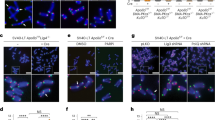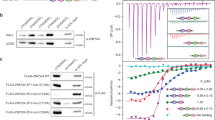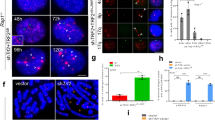Abstract
Ku70–Ku80 heterodimers promote the non-homologous end-joining (NHEJ) of DNA breaks and, as shown here, the fusion of dysfunctional telomeres. Paradoxically, this heterodimer is also located at functional mammalian telomeres and interacts with components of shelterin, the protein complex that protects telomeres1,2,3,4,5,6. To determine whether Ku contributes to telomere protection, we analysed Ku70−/− mouse cells7. Telomeres of Ku70−/− cells had a normal DNA structure and did not activate a DNA damage signal. However, Ku70 repressed exchanges between sister telomeres — a form of homologous recombination implicated in the alternative lengthening of telomeres (ALT) pathway8. Sister telomere exchanges occurred at approximately 15% of the chromosome ends when Ku70 and the telomeric protein TRF2 were absent. Combined deficiency of TRF2 and another NHEJ factor, DNA ligase IV, did not elicit this phenotype. Sister telomere exchanges were not elevated at telomeres with functional TRF2, indicating that TRF2 and Ku70 act in parallel to repress recombination. We conclude that mammalian chromosome ends are highly susceptible to homologous recombination, which can endanger cell viability if an unequal exchange generates a critically shortened telomere. Therefore, Ku- and TRF2-mediated repression of homologous recombination is an important aspect of telomere protection.
This is a preview of subscription content, access via your institution
Access options
Subscribe to this journal
Receive 12 print issues and online access
$209.00 per year
only $17.42 per issue
Buy this article
- Purchase on Springer Link
- Instant access to full article PDF
Prices may be subject to local taxes which are calculated during checkout




Similar content being viewed by others
References
Hsu, H. L., Gilley, D., Blackburn, E. H. & Chen, D. J. Ku is associated with the telomere in mammals. Proc. Natl Acad. Sci. USA 96, 12454–12458 (1999).
Hsu, H. L. et al. Ku acts in a unique way at the mammalian telomere to prevent end joining. Genes Dev. 14, 2807–2812 (2000).
Song, K., Jung, D., Jung, Y., Lee, S. G. & Lee, I. Interaction of human Ku70 with TRF2. FEBS Lett. 481, 81–85 (2000).
d'Adda di Fagagna, F. et al. Effects of DNA nonhomologous end-joining factors on telomere length and chromosomal stability in mammalian cells. Curr. Biol. 11, 1192–1116 (2001).
Gilley, D. et al. DNA-PKcs is critical for telomere capping. Proc. Natl Acad. Sci. USA 98, 15084–15088 (2001).
O'Connor, M. S., Safari, A., Liu, D., Qin, J. & Songyang, Z. The human Rap1 protein complex and modulation of telomere length. J. Biol. Chem. 279, 28585–28591 (2004).
Gu, Y. et al. Growth retardation and leaky SCID phenotype of Ku70-deficient mice. Immunity 7, 653–665 (1997).
Dunham, M. A., Neumann, A. A., Fasching, C. L. & Reddel, R. R. Telomere maintenance by recombination in human cells. Nature Genet. 26, 447–450 (2000).
de Lange, T. Shelterin: the protein complex that shapes and safeguards human telomeres. Genes Dev. 19, 2100–2110 (2005).
Celli, G. & de Lange, T. DNA processing not required for ATM-mediated telomere damage response after TRF2 deletion. Nature Cell Biol. 7, 712–718 (2005).
Smogorzewska, A. & de Lange, T. Different telomere damage signaling pathways in human and mouse cells. EMBO J. 21, 4338–4348 (2002).
Ma, J. L., Kim, E. M., Haber, J. E. & Lee, S. E. Yeast Mre11 and Rad1 proteins define a Ku-independent mechanism to repair double-strand breaks lacking overlapping end sequences. Mol. Cell. Biol. 23, 8820–8828 (2003).
Walker, J. R., Corpina, R. A. & Goldberg, J. Structure of the Ku heterodimer bound to DNA and its implications for double-strand break repair. Nature 412, 607–614 (2001).
Griffith, J. D. et al. Mammalian telomeres end in a large duplex loop. Cell 97, 503–514 (1999).
Stansel, R. M., de Lange, T. & Griffith, J. D. T-loop assembly in vitro involves binding of TRF2 near the 3′ telomeric overhang. EMBO J. 20, 5532–5540 (2001).
Bertuch, A. A. & Lundblad, V. Which end: dissecting Ku's function at telomeres and double-strand breaks. Genes Dev. 17, 2347–2350 (2003).
Riha, K., Watson, J. M., Parkey, J. & Shippen, D. E. Telomere length deregulation and enhanced sensitivity to genotoxic stress in Arabidopsis mutants deficient in Ku70. EMBO J. 21, 2819–2826 (2002).
Espejel, S. et al. Mammalian Ku86 mediates chromosomal fusions and apoptosis caused by critically short telomeres. EMBO J. 21, 2207–2219 (2002).
Samper, E., Goytisolo, F. A., Slijepcevic, P., van Buul, P. P. & Blasco, M. A. Mammalian Ku86 protein prevents telomeric fusions independently of the length of TTAGGG repeats and the G-strand overhang. EMBO Rep. 1, 244–252 (2000).
d'Adda di Fagagna, F. et al. A DNA damage checkpoint response in telomere-initiated senescence. Nature 426, 194–198 (2003).
Takai, H., Smogorzewska, A. & de Lange, T. DNA damage foci at dysfunctional telomeres. Curr. Biol. 13, 1549–1556 (2003).
Bailey, S. M., Brenneman, M. A. & Goodwin, E. H. Frequent recombination in telomeric DNA may extend the proliferative life of telomerase-negative cells. Nucleic Acids Res. 32, 3743–3751 (2004).
Bechter, O. E., Zou, Y., Walker, W., Wright, W. E. & Shay, J. W. Telomeric recombination in mismatch repair deficient human colon cancer cells after telomerase inhibition. Cancer Res. 64, 3444–3451 (2004).
Bailey, S. M., Cornforth, M. N., Kurimasa, A., Chen, D. J. & Goodwin, E. H. Strand-specific postreplicative processing of mammalian telomeres. Science 293, 2462–2465 (2001).
Wang, Y. et al. An increase in telomere sister chromatid exchange in murine embryonic stem cells possessing critically shortened telomeres. Proc. Natl Acad. Sci. USA 102, 10256–10260 (2005).
Laud, P. R. et al. Elevated telomere-telomere recombination in WRN-deficient, telomere dysfunctional cells promotes escape from senescence and engagement of the ALT pathway. Genes Dev. 19, 2560–2570 (2005).
Wang, R. C., Smogorzewska, A. & de Lange, T. Homologous recombination generates T-loop-sized deletions at human telomeres. Cell 119, 355–368 (2004).
Pierce, A. J., Hu, P., Han, M., Ellis, N. & Jasin, M. Ku DNA end-binding protein modulates homologous repair of double-strand breaks in mammalian cells. Genes Dev. 15, 3237–3242 (2001).
Weinstock, D. M. & Jasin, M. Alternative pathways for the repair of RAG-induced DNA breaks. Mol. Cell. Biol. 26, 131–139 (2006).
Adachi, N., Ishino, T., Ishii, Y., Takeda, S. & Koyama, H. DNA ligase IV-deficient cells are more resistant to ionizing radiation in the absence of Ku70: Implications for DNA double-strand break repair. Proc. Natl Acad. Sci. USA 98, 12109–12113 (2001).
DuBois, M. L., Haimberger, Z. W., McIntosh, M. W. & Gottschling, D. E. A quantitative assay for telomere protection in Saccharomyces cerevisiae. Genetics 161, 995–1013 (2002).
Polotnianka, R. M., Li, J. & Lustig, A. J. The yeast Ku heterodimer is essential for protection of the telomere against nucleolytic and recombinational activities. Curr. Biol. 8, 831–834 (1998).
Baumann, P. & Cech, T. R. Protection of telomeres by the Ku protein in fission yeast. Mol. Biol. Cell 11, 3265–3275 (2000).
Bianchi, A. & de Lange, T. Ku binds telomeric DNA in vitro. J. Biol. Chem. 274, 21223–21227 (1999).
Li, G., Nelsen, C. & Hendrickson, E. A. Ku86 is essential in human somatic cells. Proc. Natl Acad. Sci. USA 99, 832–837 (2002).
Acknowledgements
We are grateful to F. Alt for providing the Ku70 and DNA ligase IV knockout mice and to D. White for mouse husbandry. T. Halazonetis is thanked for generous gifts of the 53BP1 antibody. G.B.C. was supported by the Leukemia and Lymphoma Society. E.L.D. was supported by an Irma T. Hirschl fellowship. This work was supported by a grant from the National Institutes of Health (GM49046).
Author information
Authors and Affiliations
Corresponding author
Ethics declarations
Competing interests
The authors declare no competing financial interests.
Supplementary information
Supplementary Information
Supplementary Figure S1 (PDF 112 kb)
Rights and permissions
About this article
Cite this article
Celli, G., Denchi, E. & de Lange, T. Ku70 stimulates fusion of dysfunctional telomeres yet protects chromosome ends from homologous recombination. Nat Cell Biol 8, 885–890 (2006). https://doi.org/10.1038/ncb1444
Received:
Accepted:
Published:
Issue Date:
DOI: https://doi.org/10.1038/ncb1444
This article is cited by
-
Inhibition of CXorf56 promotes PARP inhibitor-induced cytotoxicity in triple-negative breast cancer
npj Breast Cancer (2023)
-
Shaping human telomeres: from shelterin and CST complexes to telomeric chromatin organization
Nature Reviews Molecular Cell Biology (2021)
-
DNA–dependent protein kinase in telomere maintenance and protection
Cellular & Molecular Biology Letters (2020)
-
H3K36 dimethylation by MMSET promotes classical non-homologous end-joining at unprotected telomeres
Oncogene (2020)
-
The role of telomere-binding modulators in pluripotent stem cells
Protein & Cell (2020)



